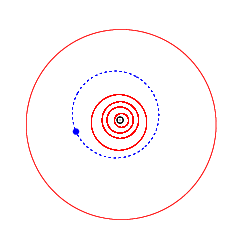9995 Alouette
|
| |||||||||||||
| Discovery[1] | |||||||||||||
|---|---|---|---|---|---|---|---|---|---|---|---|---|---|
| Discovered by | C. J. van Houten, I. van Houten-Groeneveld & T. Gehrels | ||||||||||||
| Discovery date | 24 September 1960 | ||||||||||||
| Designations | |||||||||||||
Named after | Alouette 1 | ||||||||||||
| 4805 P-L, 1981 EP22 | |||||||||||||
| Orbital characteristics[2] | |||||||||||||
| Epoch 13 January 2016 (JD 2457400.5) | |||||||||||||
| Uncertainty parameter 0 | |||||||||||||
| Observation arc | 23709 days (64.91 yr) | ||||||||||||
| Aphelion | 2.7741527 AU (415.00734 Gm) | ||||||||||||
| Perihelion | 2.0073168 AU (300.29032 Gm) | ||||||||||||
| 2.3907348 AU (357.64884 Gm) | |||||||||||||
| Eccentricity | 0.1603766 | ||||||||||||
| 3.70 yr (1350.2 d) | |||||||||||||
| 122.43917° | |||||||||||||
| 0° 15m 59.864s / day | |||||||||||||
| Inclination | 2.313074° | ||||||||||||
| 20.877950° | |||||||||||||
| 198.17238° | |||||||||||||
| Earth MOID | 0.999228 AU (149.4824 Gm) | ||||||||||||
| Jupiter MOID | 2.19848 AU (328.888 Gm) | ||||||||||||
| Jupiter Tisserand parameter | 3.514 | ||||||||||||
| Physical characteristics | |||||||||||||
| |||||||||||||
| S-type asteroid[3] | |||||||||||||
| 15.0 | |||||||||||||
|
| |||||||||||||
9995 Alouette is an S-type main belt asteroid. It orbits the Sun once every 3.69 years.[2]
Discovered on September 24, 1960 by C. J. van Houten and I. van Houten-Groeneveld on archived photographic plates made by T. Gehrels, it was given the provisional designation 4805 P-L. It was later renamed Alouette in honour of Alouette-1, the first Canadian satellite.
References
- ↑ MPC 41571 Minor Planet Center
- 1 2 "9995 Alouette (4805 P-L)". JPL Small-Body Database. NASA/Jet Propulsion Laboratory. Retrieved 13 April 2016.
- ↑ Gianluca Masi; Sergio Foglia & Richard P. Binzel. "Search for Unusual Spectroscopic Candidates Among 40313 minor planets from the 3rd Release of the Sloan Digital Sky Survey Moving Object Catalog".
External links
This article is issued from Wikipedia - version of the 9/10/2016. The text is available under the Creative Commons Attribution/Share Alike but additional terms may apply for the media files.
